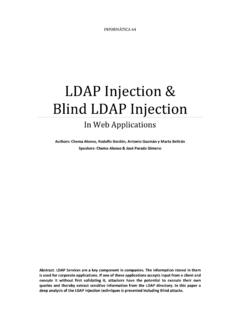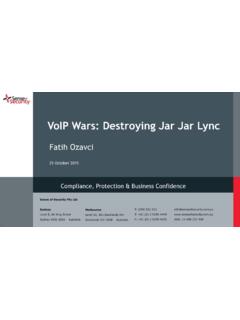Transcription of Hacking Databases for Owning your Data - Black Hat
1 Hacking Databases for Owning your DataAuthor: Cesar Cerrudo(cesar>.at.<argeniss>.dot.<com)Esteban Martinez Fayo(esteban>.at.<argeniss>.dot.<com)Argeniss Information SecurityAbstract: data theft is becoming a major threat, criminals have identified where the money is. In the last years many Databases from fortune 500 companies were compromised causing lots of money losses. This paper will discuss the data theft problem focusing on database attacks, we will show actual information about how serious the data theft problem is, we will explain why you should care about database security and common attacks will be described, the main part of the paper will be the demonstration of unknown and not well known attacks that can be used or are being used by criminals to easily steal data from your Databases , we will focus on most used database servers: MS SQL Server and Oracle database , it will be showed how to steal a complete database from Internet, how to steal data using a database rootkit and backdoor and some advanced database 0day exploits.
2 We will demonstrate that compromising Databases is not big deal if they haven't been properly secured. Also it will be discussed how to protect against attacks so you can improve database security at your : By one estimate, 53 million people have had data about themselves exposed over the past 13 months - InformationWeek, 03/20/2006 [1]That is old news, right now the number of people that have had their data exposed is more than 100 million!This is just starting, attacks will increase in number and sophistication. In the next image you can see the Top 10 Customer data -Loss Incidents as of March 2006:If you want to be more scared just take a look at: Information SecurityThere, a chronology of data breaches is kept up to date by Privacy Rights Clearinghouse [2].These data breaches not only prejudice people that has their data compromised, the biggest damage is caused to the company affected by the breach, in order to illustrate this let's see some estimated money loses of some companies that didn't take care of the data : ChoicePoint: $15 million 's Wholesale: $10 million Acxiom: $850,000 Providence Health System: $9 millionThose numbers speak by about people has more value than people think, let's see and estimation of how much personal data worth (Open market pricing of personal data from Swipe Toolkit [3]) :You can see why cyber criminals are going for your data , of course on Black market the prices won't be the same (maybe yes), but 20% of these prices multiplied by let's say 100,000 records it's good money for a point and click few minutes job (hack).
3 Why database security?:You must care about database security because Databases are where your most valuable data rest: Corporate data . Customer data . Financial data . your Databases stop working your company stops working too, try to do a quick -3- Information Securityestimation about how much money you will lose if your Databases stop working for a couple of hours, for a day, a week, etc. instantly you will realize that your Databases are the most important thing in your company. I was talking about Databases stop working without mentioning a reason, what about if your Databases get hacked, then your company can lose millions, in worst case it can run out of must comply with regulations, laws, etc.: Sarbanes Oxley (SOX). Payment Card Industry (PCI) data Security Standard. Healthcare Services (HIPAA) . Financial Services (GLBA) . California Senate Bill No. 1386 . data Accountability and Trust Act ( data ). that list gets bigger every day, but complying with regulations and laws is not our topic right now, it's deserves another vulnerabilities affect all database vendors, I know it's old news but guess what?
4 It's still a big issue, some vendors as our loved Oracle (DB2 doesn't seem much better!!) are more affected than others. For instance, on 2006 Oracle released 4 Critical Patch Updates related with database server, more than 20 remote (no authentication required) vulnerabilities were fixed, but that's not the worst new, currently there are more than 50 vulnerabilities that are still un-patched on Oracle database , so no matter if your database servers are up to date with patches they still can be easily hacked. To give an idea of how buggy are database servers let me quickly mention how many 0days Argeniss currently has: DB2: 8 Informix: 2 Oracle: >50 Nowadays perimeter defense is strong and secure but that's not enough, Databases have many entry points such as web applications, internal networks, partners networks, etc. Any regular database user can hack a database if it's not properly monitored. No matter if operating systems and networks are properly secured, Databases still could: be mis-configured, have weak passwords, be vulnerable to unknown and known vulnerabilities, Databases are hacked?
5 :It's important to mention how Databases are hacked, having this in mind helps you to better protect them. Let's enumerate some common guessing/brute-forcing:If passwords are blank or not strong they can be easily guessed/brute-forced. After a valid user account is found is easy to complete compromise the database , especially if the database is and data sniffed over the network:If encryption is not used, passwords and data can be easily mis-configurations:Some database servers are open by default. Lots of functionality enabled and most of the time insecurely Information SecurityDelivering a Trojan:This is not a common database server attack but it's something we are researching and the results are scary, soon we will have one beautiful beast ready, maybe on next paper you will know it. A trojan can be delivered by email, p2p, IM, CD, DVD, pen drive, etc. Once it gets executed on a desktop computer by a company employee, it will get database servers and users information in an automatic and stealth way using ODBC, OLEDB, JDBC configured connections, sniffing, etc.
6 When enough information is collected the trojan can connect to database servers, it could try default accounts if necessary. After a successful login it will be ready to steal data , it could run a 0day to elevate privileges to own the complete database server and also install a database rootkit to hide its actions. All the previous steps will be repeated on every database server found. The trojan can send the stolen data encrypted back to attacker by email, HTTP, covert channel, known/unknown vulnerabilities:Attackers can exploit buffer overflows, SQL Injection, etc. in order to own the database attack could be through a web application by exploiting SQL Injection so no authentication is needed. In this way Databases can be hacked from Internet and firewalls are complete bypassed. This is one of the easiest and preferred method that criminals use to steal sensitive information such as credit cards, social security numbers, customer information, disks and backup tapes:This is something that is not commonly mentioned, companies always say that disks or backups were lost :)If data files and backed up data are not encrypted, once stolen data can be easily a rootkit/backdoor:By installing a rootkit actions and database objects can be hidden so administrators won't notice someone hacked the database and continues having access.
7 A database backdoor can be used, designed to steal data and send it to attacker and/or to give the attacker stealth and unrestricted access at any given database attacks:Now let s see some attacks for Oracle data using a rootkit and backdoor:To steal data from a database the best option seems to be the combination of a database rootkit and a database backdoor. This will allow an attacker to administer a database from a remote location and to be hidden from the database Rootkits:A rootkit is a set of tools used by an attacker after Hacking a computer system that hides logins, processes, etc. It is commonly used to hide the operation of an attacker in a compromised system. Rootkits are more widespread in Operating Systems but the idea is applicable to Databases are different ways to implement rootkits in Oracle Databases , for more information see [7].This paper shows an example of a rootkit that modifies data dictionary views to hide the attacker database Backdoors:This kind of backdoors allows attackers to execute commands and queries on the database -5- Information Securityfrom a remote location and get the responses from the don t want to be visible to database administrators, so backdoors can be used in combination with rootkits to hide the backdoor operations from the an Oracle database Backdoor:To implement an Oracle database Backdoor an attacker can write a program in PL/SQL, Java or a combination of program will do basically three things: Use built-in network functionality to open a connection to the attacker s host.
8 Read the connection and execute the commands the attacker sends. Write to the opened connection the output of the program (the backdoor) can be scheduled, using the Job functionality, to run periodically, so if the connection is lost or the database instance is restarted, the attacker will get connected at a later order to avoid detection, the communication between the backdoor and the attacker s host can be encrypted or encoded in some way that is not detected by an IDS or IPS and that is not understandable to someone that is looking at the network example of a Backdoor and Rootkit:This example consists of two parts. One part are the PL/SQL scripts that needs to be run on the Oracle database server with administrator privileges (the attacker will have to run these scripts using an exploit to elevate privileges or get administrative access to the server) and the other part is the Backdoor Console:The Backdoor Console is a GUI application that the attacker runs on his/her computer.
9 It allows the attacker to: Send commands to the Backdoor and receive the output. View information about the deployed Backdoor. Configure the Backdoor. Manage multiple between the Backdoor and the Backdoor Console:The Backdoor installed in the database server and the Backdoor Console that is running on the attacker s host use TCP/IP to communicate. The Backdoor Console listens on a predefined TCP port (4444) waiting for connections from the database server the Backdoor starts, it opens an outgoing TCP connection to a predefined host and port where the Backdoor Console is listening. The first message that the Backdoor sends, contains information about the owned database : database Server type (Oracle, SQL Server), Version, database name and database Information SecurityBackdoor Console screenshotThen the Backdoor enters a loop repeating these operations: Reads from the TCP/IP connection and executes the commands it receives from the Backdoor Console.
10 Sends the output to the Backdoor Console. Sends an [[EnD]] string meaning there is no more output for the loops until the EXIT command is received. When the Backdoor receives the EXIT command, it closes the TCP Console Listen onTCP Port ShowsnewownedDB Sendcommand Show output SendInfoaboutownedDB Executecommand SendOutputAttackerhost(remote)Oracle DatabaseServerLoopuntil EXIT isreceivedCommunication between the Backdoor Console and the Backdoor installed in the database -7- Information SecurityPL/SQL Scripts:These are PL/SQL scripts that will install (or uninstall) the rootkit and the backdoor in an Oracle :This script creates a function that modifies the data dictionary views DBA_JOBS, DBA_JOBS_RUNNING, KU$_JOB_VIEW to hide the backdoor function can be injected in any SQL Injection vulnerability where a function call can be injected as is the case of many SQL Injection vulnerabilities recently found in Oracle is the script that installs the backdoor.












